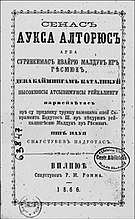
Back Забарона літоўскага друку Byelorussian Забарона летувіскага друку BE-X-OLD Prohibición de prensa lituana Galician Pencekalan pers Lituania ID Bando della stampa lituana Italian Литва латиницаны джасакълау KRC Spaudos draudimas Lithuanian Запрет на литовскую латиницу Russian Заборона литовського друку Ukrainian 立陶宛書刊禁令 Chinese
The Lithuanian press ban (Lithuanian: spaudos draudimas) was a ban on all Lithuanian language publications printed in the Latin alphabet in force from 1865 to 1904 within the Russian Empire, which controlled Lithuania proper at the time. Lithuanian-language publications that used Cyrillic were allowed and even encouraged.
The concept arose after the failed January Uprising of 1863, taking the form of an administrative order in 1864, and was not lifted until 24 April 1904. The Russian courts reversed two convictions in press ban cases in 1902 and 1903, and the setbacks of the Russo-Japanese War in early 1904 brought about a loosened Russian policy towards minorities.[1]
Under the ban, it was illegal to print, import, distribute, or possess any publications in the Latin alphabet.[2] Tsarist authorities hoped that this measure, part of a larger Russification plan, would decrease Polish influence on Lithuanians and would return them to what were considered their ancient historical ties with Russia.[3] However, Lithuanians organized printing outside the Empire, largely in Lithuania Minor (East Prussia), and in the United States.
Knygnešiai (Lithuanian book smugglers) smuggled illegal books and periodicals across the border. The number of such publications kept increasing despite strict sanctions and persecution of the activists. The ban created a well-defined and organized opposition to Russian rule and culture—the opposite of its original intent. The Lithuanian historian Edvardas Gudavičius has described the ban as a test of the concept of Lithuania: had there been no resistance, the language would have become a historical footnote.[4]
- ^ Lithuanian Resistance. Spaudos.lt, reprinted from Encyclopedia Lituanica, Boston, 1970–1978. Retrieved on 2009-03-17
- ^ Lithuania 1863–1893: Tsarist Russification And The Beginnings Of The Modern Lithuanian National Movement. Lituanus, Fall 1996. Retrieved on 2009-03-17
- ^ Cite error: The named reference
geraswas invoked but never defined (see the help page). - ^ The Year 2000: History and Contemporary Experience Archived 2007-09-27 at the Wayback Machine. Edvardas Gudavičius. Lithuanian Foreign Policy Review, 1999. Retrieved on 2009-03-17

